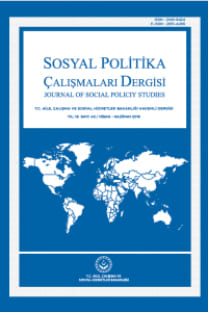BEDEN EĞİTİMİ VE SPOR ALANINDA YAPILAN GÖRME ENGELLİLERE YÖNELİK ARAŞTIRMALARIN SİSTEMATİK BİR ŞEKİLDE İNCELENMESİ
Beden Eğitimi, Spor, Görme Engelli, Çoklu Görme Yetersizliği
A SYSTEMATIC INVESTIGATION OF RESEARCH ON THE VISUAL IMPAIRMENTS IN THE FIELD OF PHYSICAL EDUCATION AND SPORTS
Physical Education, Sports, Blindness, Multiple Visual Impairments,
___
- Ajuwon, P. M., & Oyinlade, A. O. (2008). Educational placement of children who are blind or have low vision in residential and public schools: A national study of parents’ perspectives. Journal of Visual Impairment & Blindness, 102(6), 325–339.
- Blessing, D. L., McCrimmon, D., Stovall, J., & Williford, H. N. (1993). The effects of regular exercise programs for visually impaired and sighted schoolchildren. Journal of Visual Impairment & Blindness, 87(2), 50–52.
- CDC: Centers for Disease Control and Prevention. (2011). Physical activity & health. Retrieved from http://www.cdc.gov/physicalactivity/ everyone/health/index.html
- Chaapel, H., Columna, L., Lytle, R., & Bailey, J. (2012). Parental expectations about adapted physical education services. Journal of Special Education. Retrieved from http://sed.sagepub.com/content/early/ 2012/05/29/0022466912447661.full.pdf.
- Haegele, J. A., & Lieberman, L. J. (2016). The current experiences of physical education teachers at schools for blind students in the United States. Journal of Visual Impairment & Blindness, 110(5), 323-334.
- Haegele, J. A., & Porretta, D. L. (2015). Physical activity and school-age individuals with visual impairments: A literature review. Adapted Physical Activity Quarterly, 32(1), 68 – 82. doi:10.1123/apaq.2013-0110
- Haegele, J. A., & Zhu, X. (2017). Experiences of individuals with visual impairments in integrated physical education: A retrospective study. Research quarterly for exercise and sport, 88(4), 425-435.
- Haegele, J. A., Hodge, S. R., Zhu, X., Holland, S. K., & Wilson, W. J. (2019). Understanding the inclusiveness of integrated physical education from the perspectives of adults with visual impairments. Adapted Physical Activity Quarterly, 37(2), 141-159.
- Haegele, J. A., Lieberman, L. J., Columna, L., & Runyan, M. (2014). Infusing the Expanded Core Curriculum into Physical Education for Children with Visual Impairments. Palaestra, 28(3).
- Haegele, J. A., Zhu, X., & Davis, S. (2017). The meaning of physical education and sport among elite athletes with visual impairments. European Physical Education Review, 23(4), 375-391.
- LaVenture, S. (2003). The Individuals with Disabilities Education Act (IDEA): Past and present. Journal of Visual Impairment & Blindness, 97(9), 517–518
- Lieberman, L. J., Houston-Wilson, C., & Kozub, F. M. (2002). Perceived barriers to including students with visual impairments in general physical education. Adapted Physical Activity Quarterly, 19(3), 364-377.
- Lieberman, L. J., Ponchillia, P., & Ponchillia, S. (2013). Physical education and sport for individuals with visual impairments or deaf-blindness: Foundations of instruction. New York: American Foundation of the Blind.
- Oh, H., Ozturk, M., & Kozub, F. (2004). Physical activity and social engagement patterns during physical education of youth with visual impairments. Rehabilitation & Education for Blindness & Visual Impairment, 34(1), 39 – 48.
- Perkins, K., Columna, L., Lieberman, L. J., & Bailey, J. (2013). Parents’ perceptions of physical activity for their children with visual impairments. Journal of Visual Impairment & Blindness, 107(2), 131–142
- Schedlin, H., Lieberman, L. J., HoustonWilson, C., & Cruz, L. (2012). Academic learning time in physical education of children with visual impairments: An analysis of two students. Insight: Research and Practice in Visual Impairment and Blindness, 5(1), 11–22.
- Stuart, M. E., Lieberman, L. J., & Hand, K. E. (2006). Beliefs about physical activity among children who are visually impaired and their parents. Journal of Visual Impairment & Blindness, 100, 223–234.
- Wang, X., Fang, Z. and Sun, X. (2016). Usage patterns of scholarly articles on Web of Science: a study on Web of Science usage count. Scientometrics, 109, 917-926.
- ISSN: 2148-9424
- Yayın Aralığı: 4
- Başlangıç: 2012
- Yayıncı: Aile,Çalışma ve Sosyal Hizmetler Bakanlığı
TÜRKİYE’DE DEĞİŞEN DOĞURGANLIK TERCİHLERİ: PARİTEYE GÖRE ANALİZLER
Ayşe ABBASOĞLU ÖZGÖREN, Ahmet Sinan TÜRKYILMAZ
ÇOCUK EVLERİNDE ÇALIŞAN BAKIM ELEMANLARININ PSİKOLOJİK İYİ OLUŞ DÜZEYLERİNİN İNCELENMESİ
Esma İNCE KESER, Haktan DEMİRCİOĞLU
BABALARIN ÇOCUKLARINA YÖNELİK ALGISI: İLK BABALIK DENEYİMLERİ
Ahmet EROL, Merve CANBELDEK, Nesrin IŞIKOĞLU
AÇIK HAVA OYUN PARKLARINDA RİSKLİ OYUNA ÇOK YÖNLÜ BAKIŞ
